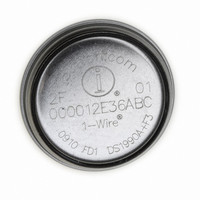DS1982-F5+ Maxim Integrated Products, DS1982-F5+ Datasheet - Page 6

DS1982-F5+
Manufacturer Part Number
DS1982-F5+
Description
IBUTTON 1KBit ADD-ONLY F5
Manufacturer
Maxim Integrated Products
Series
iButton®r
Datasheet
1.DS1982-F5.pdf
(24 pages)
Specifications of DS1982-F5+
Rohs Information
IButton RoHS Compliance Plan
Memory Size
128B
Memory Type
EPROM
Lead Free Status / RoHS Status
Lead free / RoHS Compliant
DS1982
1024-BIT EPROM
The memory map in Figure 5 shows the 1024-bit EPROM section of the DS1982 that is configured as
four pages of 32 bytes each. The 8-bit scratchpad is an additional register that acts as a buffer when
programming the memory. Data is first written to the scratchpad and then verified by reading an 8-bit
CRC from the DS1982 that confirms proper receipt of the data. If the buffer contents are correct, a
programming voltage should be applied and the byte of data will be written into the selected address in
memory. This process ensures data integrity when programming the memory. The details for reading and
programming the 1024-bit EPROM portion of the DS1982 are given in the "Memory Function
Commands" section.
EPROM STATUS BYTES
In addition to the 1024 bits of data memory the DS1982 provides 64 bits of status memory accessible
with separate commands.
The EPROM Status Bytes can be read or programmed to indicate various conditions to the software
interrogating the DS1982. The first byte of the EPROM status memory contains the Write-Protect Page
bits that inhibit programming of the corresponding page in the 1024-bit main memory area if the
appropriate write protection bit is programmed. Once a bit has been programmed in the Write-Protect
Page byte, the entire 32-byte page that corresponds to that bit can no longer be altered but may still be
read.
The next 4 bytes of the EPROM Status Memory contain the Page Address Redirection Bytes that indicate
if one or more of the pages of data in the 1024-bit EPROM section have been invalidated and redirected
to the page address contained in the appropriate redirection byte. The hardware of the DS1982 makes no
decisions based on the contents of the Page Address Redirection Bytes. These additional bytes of status
EPROM allow for the redirection of an entire page to another page address, indicating that the data in the
original page is no longer considered relevant or valid. With EPROM technology, bits within a page can
be changed from a logical 1 to a logical 0 by programming, but cannot be changed back. Therefore, it is
not possible to simply rewrite a page if the data requires changing or updating, but with space permitting,
an entire page of data can be redirected to another page within the DS1982 by writing the one’s
complement of the new page address into the Page Address Redirection Byte that corresponds to the
original (replaced) page.
This architecture allows the user’s software to make a “data patch” to the EPROM by indicating that a
particular page or pages should be replaced with those indicated in the Page Address Redirection Bytes.
If a Page Address Redirection Byte has a FFH value, the data in the main memory that corresponds to that
page is valid. If a Page Address Redirection Byte has some other hex value, the data in the page
corresponding to that redirection byte is invalid, and the valid data can now be found at the one’s
complement of the page address indicated by the hex value stored in the associated Page Address
Redirection Byte. A value of FDH in the redirection byte for page 1, for example, would indicate that the
updated data is now in page 2. The details for reading and programming the EPROM status memory
portion of the DS1982 are given in the Memory Function Commands section.
Page 6 of 24












